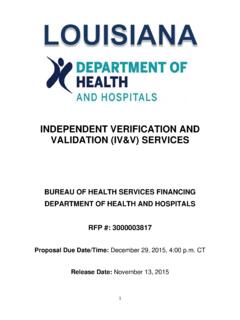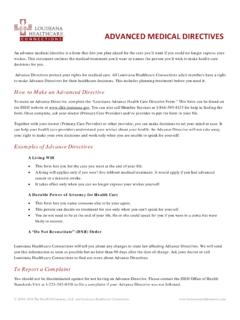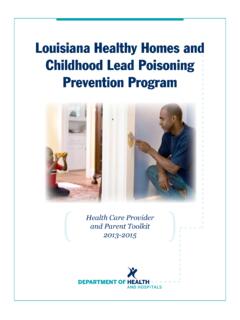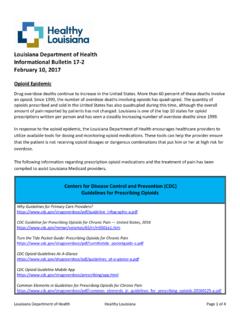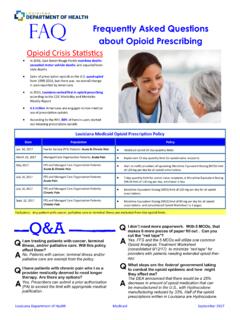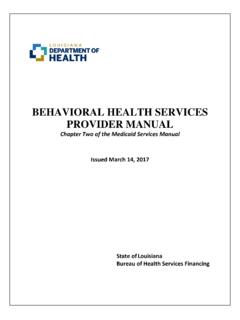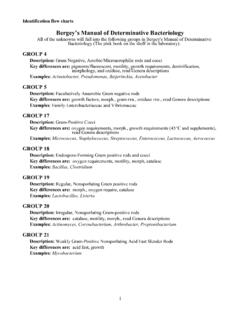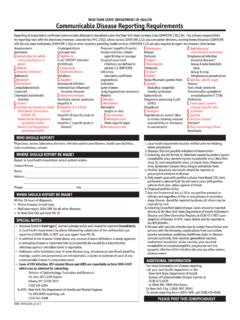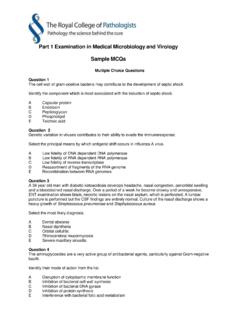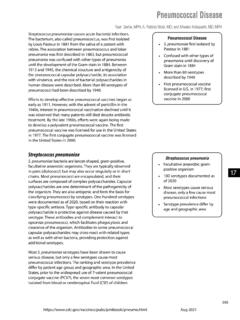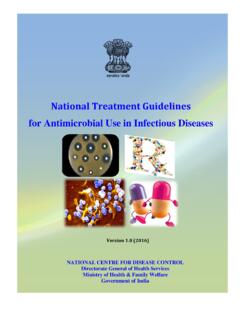Transcription of Colonization v. Infection - Louisiana Department of Health
1 Colonization vs Infection1 Infection v. ColonizationMulti Drug Resistant Organisms Management in Long Term Care Facilities WorkshopLouisiana Office of Public HealthHealthcare Associated Infections ProgramObjectivesBy the end of the presentation, attendees will be able to: Define Colonization Differentiate Colonization from infections Apply appropriate laboratory test by common LTC infectious agents Understand the necessity of communicating infectious status upon patient transferColonization The presence of microorganisms in or on a host with growth and multiplication but without tissue invasion or damage Understanding this concept is essential in the planning and implantation of epidemiological studies in a healthcare Infection prevention and control program Confusing Colonization with Infection can lead to spurious associations that may lead to expensive, ineffective, and time consuming interventions Colonization may become Infection when changes in the host occurColonization.
2 Definition Colonization :presence of a microorganism on/in a host, with growth and multiplication of the organism, but without interaction between host and organism (no clinical expression, no immune response). Carrier:individual which is colonized + more Subclinical or unapparent Infection :presence of microorganism and interaction between host and microorganism (sub clinical response, immune response). Often the term Colonization is applied for relationship host agent in which the immune response is difficult to elicit. Contamination: Presence of a microorganism on a body surface or an inanimate vs Infection2 CarrierA carrieris an individual that harbors a specific microorganism in the absence of discernible clinical disease and serve as a potential source of Infection .
3 A carrier may be an individual who is: colonized infected and asymptomatic in incubation period before disease convalescent from acute diseaseThe carrier status may be short or about carrier as Source Explanation for person who apparently is not infectedInfection The replication of organisms in host tissue which may cause disease Infection : defines the entrance and development of an infectious agent in a human or animal body, whether or not it develops into a disease Caused by an infectious agent: all micro or macro organisms capable of producing an Infection or an infectious disease Infectious disease: an illness caused by a specific infectious agent or its toxic product that results from transmission of that agent or its product from an infected person, animal, or reservoir to a susceptible hostSpectrum: No Exposure Exposure Colonization Infection DiseaseHost + Infectious agent No foothold: Exposed Foothold, no reactionColonizationCarrier Foothold: epithelial attachment Multiplication: Infection Direct cytotoxicity Toxins Tissue disruption Tissue injury Dissemination Asymptomatic SymptomaticWhat is Exposed ?
4 Means of transmission: Being in the same room as an infectious tuberculous patient or with a person with HIV Specific information: Eating a meal or eating the contaminated food item?Exposure definition relies on information that may not be all known. OROPHARYNXS treptococcus viridansgroupStreptococcus pyogenesStreptococcus pneumoniaeStaphylococciMoraxella catarrhalisNeisseriasppCorynebacteriumsp pHaemophilussppAnaerobes: BacteroidesCandida albicansSKINS taphylococciCorynebacteriaPropionibacter iaCandidaMalassezia furfurCONJUNCTIVAS taphylococciCorynebacteriaHaemophilusGEN ITOURINARY TRACTS taphylococci, StreptococciEnterococciLactobacillus spp, CorynebacteriumNeisseriaspp, AnaerobesCandida albicansUPPER INTESTINES treptococciLactobacillus sppCandida sppNASOPHARYNXS taphylococciStreptococciMoraxella catarrhalisNeisseriasppHaemophilussppLOW ER INTESTINEA erobic G- bacilli.
5 , KlebsEnterobacter, Proteus, SerratiaProvidencia, Bacteroides, AnaerobicEnterococci, Streptococci, CandidaFlora at Colonization SitesColonization vs Infection3 Skin Hand FloraRESIDENT FLORA Survives on the skin more than 24 hours Not easily removed, hours of scrubbing Complete stelirizationimpossible Low virulence Staphylococci, diphteroides, mostly Gram + , very few Gram TRANSIENT FLORA Survive on skin less than 24 hours Easily removed with soap and water Acquired during contacts with contaminated areas mouth, nose, perineal area, genitals, anal area, catheter, bedpan, urinal, patient care casual contact May have high virulence Enterobacteria, Gram bacilli, in Colonization Flora General shift towards Gram negative flora in hospitals, LTCF and other Health care facilities Modification of the skin environment due to skin changes still poorly understood Invasive procedures provides portal of entry to different flora Antibiotic therapy: In a study of patients on ampicillin long term Rx, 90% colonized by ampicillin resistant Enterobacteriae, controls only 10% Colonization Protects the HostNormal floraprotectsagainst infectious diseases originating at are severalmechanisms for protection.
6 Non specific stimulation of immune responsiveness Specific cross reactive immunization Competitive bacterial interferenceGerm free animals reared in good Health succumb rapidly from overwhelming Infection when transferred with normal healthy animalsNumber of bacteria to colonize gut Normal animal, 10,000,000 Germ free animal, 100 Clinical InfectionClinical Infection : Clinical Infection may result in signs and symptoms. Some of these may be less obvious or very minor. At the end of the spectrum is the individual with no sign, no symptoms who has a asymptomatic Infection or subclinical Infection . Asymptomatic Infection does not mean that all is quiet . It may cover some very active processes as in the asymptomatic phase of HIV Infection , tuberculosis Infection , hepatitis B carrier vs Infection4 True Infection NOT Colonization Infections are accompanied by signs and symptoms: fever, malaise in localized infections: swelling due to inflammation, heat, pain, erythema (tumor, dolor, rubor, calor) Use definitions which establish minimum characteristics for Infection Remember: Immunocompromised patients do not show signs of Infection as normal patients.
7 Neutropenic patients ( 500 neutrophils /mm3) show no pyuria, no purulent sputum, little infiltrate and no large consolidation on chest X ray11NO Infection at Time of Admission establish prior negativity check history, symptoms and signs documented at time of admission, lab tests & chest X rays done normal physical examination absence of signs and symptoms normal chest X ray negative culture or lack of cultureExample: If urine cultures are collected at day 7 of hospitalization and none was collected before, it implies that no signs of Infection were present in urine before22 Excluded: Transplacentalinfections Reactivation of old infections (ex Shingles) Infections considered extensions of infections present at admissionSufficient Time to Develop Infection diseases with specific incubation period: stay in hospital incubation period numerous infections do not have well set incubation periods (for example, staphylococci, ) these infections rarely develop in less than 2 days NHSN criterion: Infection present after the 3rd hospital day (day of hospital admission is day 1).
8 33 Methicillin Resistant Staphylococcus aureus(MRSA) Colonization Approximately 30% of the population is colonized with MRSA Organism lives on the skin for long periods of time generally in warm, damp, dark areas of the body Nose Throat Armpits South of the border Infection Occurs when a bacterial strain undergoes uncontrolled growth Can be localized to a specific area such as a wound or spread through the bloodstream (bacteremia) Colonization vs Infection5 Clostridium difficile (CDIFF) Colonization Asymptomatic CDIFF is detected in the absence of symptoms of Infection The number of colonized patients is higher than symptomatic CDI cases among hospital patients Absence of diarrhea without colonoscopic histopathologicfindings of pseudomembranous colitis and Detection of CDIFF or Presence of CDIFF toxinsInfection Presence of diarrheal symptoms (3+ unformed stools in 24h) Stool tests positive for CDIFF toxins or Detection of toxigenic CDIFF or Colonoscopic findings demonstrating ulcerative colitisNo tests of cure!
9 !!!Carbapenem resistant Enterobacteriacea(CRE) Colonization Organism can be found on the body but is not causing any symptoms or disease Strains can go on to cause infections in sterile sites of the body Generally colonized in the GI tractInfection Cause infections when they enter the body through medical devices like central lines, urinary catheters, or wounds Treatment options include tigecycline, colistin, and polymixin BVancomycin resistant Enterococci (VRE) Colonization Acquired by susceptible hosts in an environment with a high rate of patient Colonization with VRE, intensive care units, oncology units Can lead to Infection depending on the Health of the patientInfection Weakened hosts have an increased likelihood of developing Infection following Colonization PCR is used to detect infections and outbreaksUrinary Tract Infections The prevalence of asymptomatic bacteriuria (ASB), bacterial Colonization of the urinary tract without local signs or symptoms of Infection , ranges from 23 50% in non catheterized NH/SNF residents to 100% among those with long term urinary catheters.
10 Differentiating ASB from symptomatic UTI can lead to inappropriate antibiotic use and its related complications. High prevalence of ASB and the challenges with diagnosing symptomatic UTI in NH/SNF residents have led to antibiotic overuse in this population. Overuse increases the likelihood of adverse events and complications of previous antibiotic treatment ( , CDI) along with emergence, transmission, and acquisition of MDROs. Appropriate diagnosis and management of symptomatic UTI is a critically important issue in the NH/SNF setting. Colonization vs Infection6 Urinary Tract Infections Recommendations Do not text asymptomatic patients Urine is not sterile Bacteria are present at low levels in the urine of healthy people not suffering from a urinary tract infectionSeek and ye shall surveillance of urinary tract infectionsAppropriate surveillance of urinary tract infectionsScreening all patients urine, regardless of presence of symptoms, upon admit to the facility.

